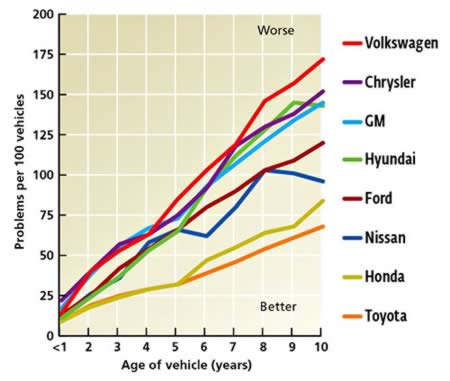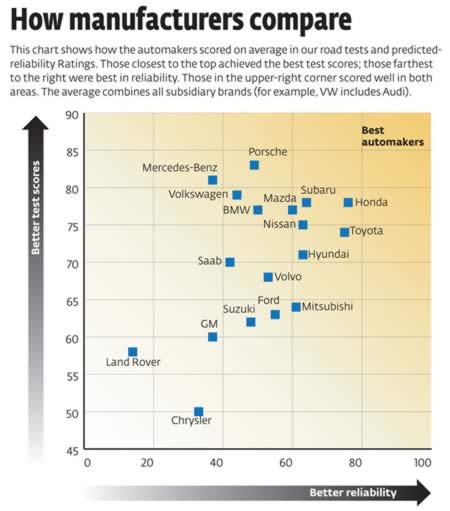The auto review issue of Consumer Reports is always very popular, due in part to the fact that they can be more impartial by actually buying all the cars they test anonymously and not accepting any outside advertising. (This is not the case with any other car magazine.) Here’s a few charts and graphs from Consumer Reports summarizing their car reliability data by brand.
Long-Term Reliability
This chart below shows a graph of problems vs. age of vehicle for 8 major automakers. The data is from their 2008 Annual Auto Survey, which had more than 1.4 million responses. A typical eight-year-old Volkswagen has almost three times the number of problems as a typical eight-year-old Toyota. [source]

Overall Test Scores and Reliability Ratings
This second chart, released in 2009, plots major automakers on two scoring scales: those from road tests by CR staff and predicted-reliability ratings based on surveys. Being in the top right corner is best. [source]

If you know of any more recent versions of these charts, let me know!
 The Best Credit Card Bonus Offers – 2025
The Best Credit Card Bonus Offers – 2025 Big List of Free Stocks from Brokerage Apps
Big List of Free Stocks from Brokerage Apps Best Interest Rates on Cash - 2025
Best Interest Rates on Cash - 2025 Free Credit Scores x 3 + Free Credit Monitoring
Free Credit Scores x 3 + Free Credit Monitoring Best No Fee 0% APR Balance Transfer Offers
Best No Fee 0% APR Balance Transfer Offers Little-Known Cellular Data Plans That Can Save Big Money
Little-Known Cellular Data Plans That Can Save Big Money How To Haggle Your Cable or Direct TV Bill
How To Haggle Your Cable or Direct TV Bill Big List of Free Consumer Data Reports (Credit, Rent, Work)
Big List of Free Consumer Data Reports (Credit, Rent, Work)
Charts better to include premium models as well…. I have 12 year old acura with 135K miles and I love it.
No wonder I’m still loving my 13 year old Honda Civic which has 176,000 miles! It has been trouble-free. Wish they’d come out with a AWD that gets 30-plus MPG! (I live in the mountains and snow).
The two charts don’t quite line up. For example, Volkswagon and GM seem to switch places. From the descriptions it sounds like the top one is from actual data, whereas the second one is just perceptions?
Road Tests (IE what it felt like) and “predicted-reliability ratings based on surveys.” Hmm. I will go with the one that uses actual data 🙂
With the latest problems Toyota had, maybe Honda has taken the crown.
@Jeff: Predicted reliability is based on the actual data, assuming that the trends continue. In this case, unlike mutial fund disclaimers, they are assuming that past performance is a predictor of future performance.
In other words, if a brand was unreliable but getting better, it may beat out another that was reliable but has been getting worse over the last few years.
Another good (in my opinion) source of car reliability information is http://www.truedelta.com. It solely uses actual data from members and you get to see the details. So not only do you see that there are three times more problems but you get to see what were the actual problems. And most people post what the cost of the repairs they had were if any.
If nothing else, it helped me ask the right questions when shopping for a new to me but used car to find out if it was having any of the problems I saw people reporting.
1995 Geo Prizm, 190,000miles. Single finest car I’ve ever owned from a frugality/reliability standpoint. Only GM car I’d ever buy, helps that it is a toyota corolla. I wonder if they thought it ironic at the time that their best car wasn’t even their own design. GM put out some horrendous junk in the 90s. Grand Am anyone?
@Alex: You’re probably safe assuming that Acura is rolled up in the Honda numbers. It’s Honda’s luxury brand.
While there may be some accuracy to the chart, I would think that the type of driver has quite a bit to do with a vehicle’s reliability. For example, if everything else is equal, someone that drives a truck for work or does a lot of off-roading would likely have more reliability problems than a senior citizen that drives a toyota sedan to church. Doesn’t mean the chart is without value, but the person driving a vehicle and how they drive it does have something to do with its reliability.
Erik wrote: “While there may be some accuracy to the chart, I would think that the type of driver has quite a bit to do with a vehicle’s reliability. …”
Yes, absolutely.
Subaru’s reputation for reliability comes partly from their traditional US buyers (e.g., mellow, green, older, female) and vehicles sold before they introduced the sport models such as the WRX and STi here. The sport models get crashed a lot, their head gaskets blow, they get worn out rapidly, etc.
Mazda is very hit-or-miss. Most Japan made cars (e.g., MX-5/Miata, 3) are very reliable, while the RX-8 (rotary engine) is not. Their US made models (e.g., rebadged Ford SUVs and trucks) work just as well as the original Ford products (so-so).
Buick consistently gets high scores and reliability numbers, but has been the classic little-old-lady-going-to-church car.
I don’t have the issue being referred to immedaitely at hand to double check, but I believe CR addresses the driving style issue by statistically eliminating driving style as a factor in the reliability ratings.
Wonder why Volvo isn’t in the top chart. Those cars last FOREVER!
This is not really showing anything that usefull.
What this doest take into account, is what type of problem occured and if it was covered by the manufactures warenty.
I have had a Hyundi elentra for 5 years no problem, had a issue with my AC but was fixed in full with the warenty.
Having a problem is only part of the equation. How much it cost you to fix a problem and how much the car cost is the other part.
Reading this chart brought a smile to my face since I just bought a fairly new BMW. I know I know..not the best investment, but you got to live a little too!
I drive a 2006 VW with only 40K miles and planned on keeping it a longtime. The first chart seems to rate it as the worst for reliablity, and the second chart seems to put it between BMW and Mercedes as best score and reliability.
Wondering if I should keep the car long after it is paid off and maintain it, or sell now and get something more reliable?
Anyone else driving a VW and have any thoughts?
SECOND CHART: I think people are reading this differently than I am (@NYC GUY liking that his is rated high, but to the left). When i read it i see that going higher on the graph is related to test scores (that’s not bad) but going to the right are ‘best in reliability’ (this is better). To me, the scores of the Benz & VW (top middle) say ‘we rated this high, but they performed worse than average’. The people who bought a Benz/VW thought (& paid) for a car they were told would perform well but in the end had just an many issues as the Chrysler (bottom middle).
I’m driving my third Subaru. All were purchased used with 60,000 or more miles. The first two served me well and brought good resale value when sold. I’m currently driving a Subaru Forester with 140,000 miles. I intend to keep it until it is well past the 200,000 mile mark. Based on my previous Subarus, I do not anticipate any major repairs, just maintenance. If an American car could do the same, I’d try it; I’m not holding my breath.
Has anyone seen a similar chart comparing number of car repairs to miles driven? This would allow me to see how many more repairs cars need with, say 120,000 miles than ones with, 50,000 miles on them.